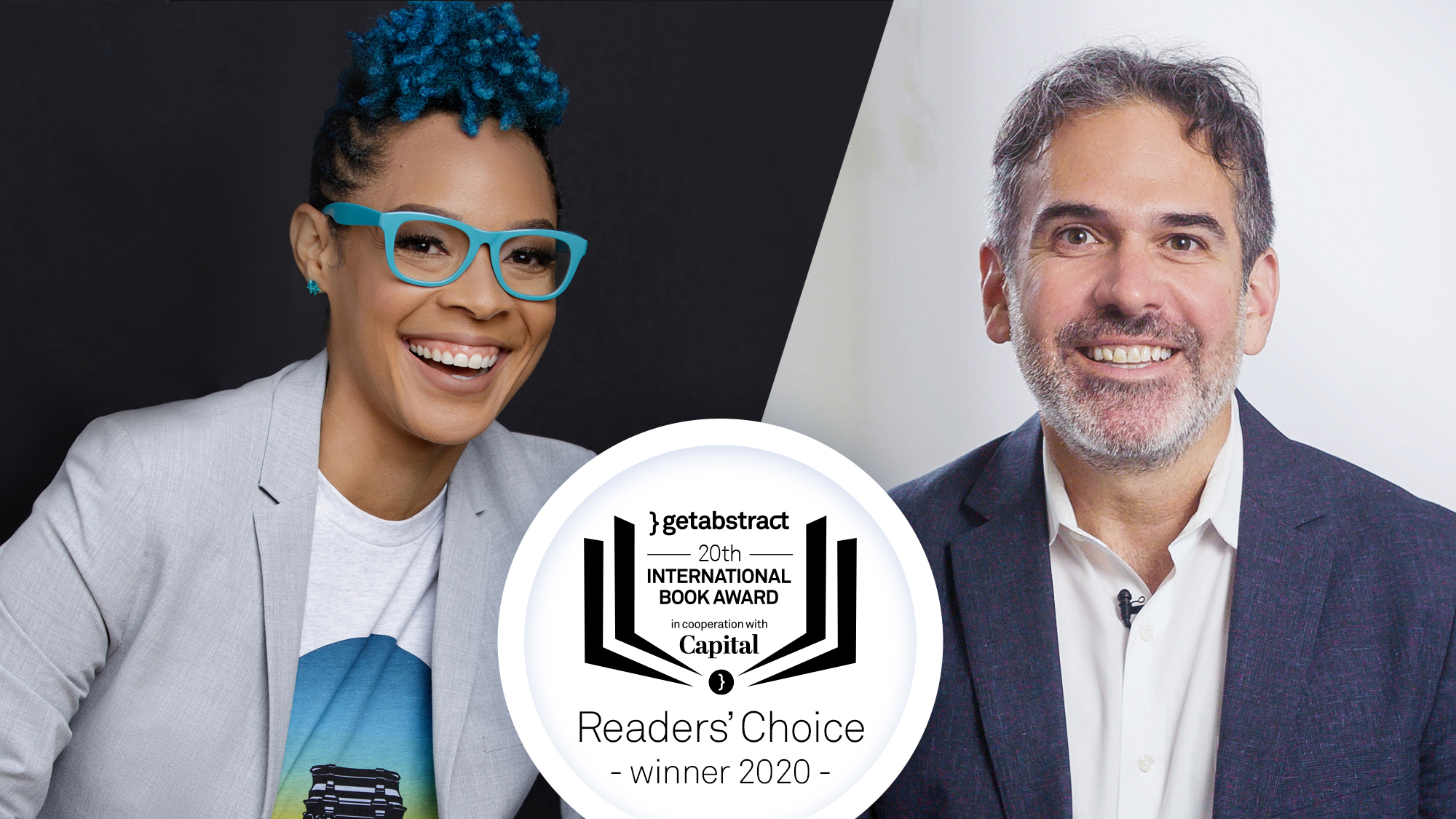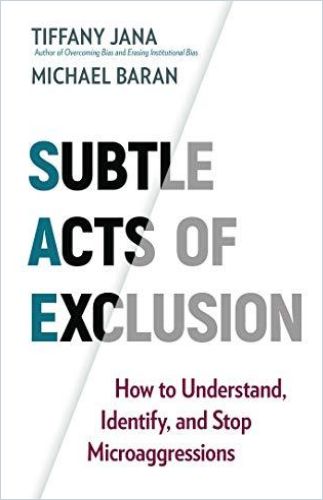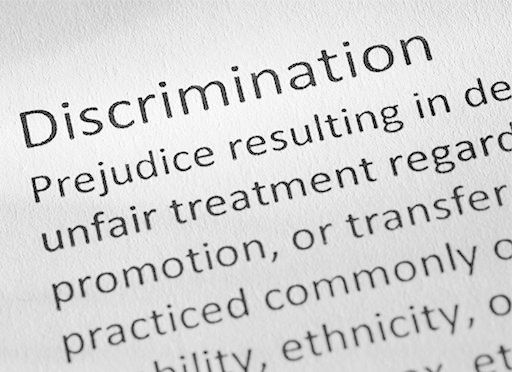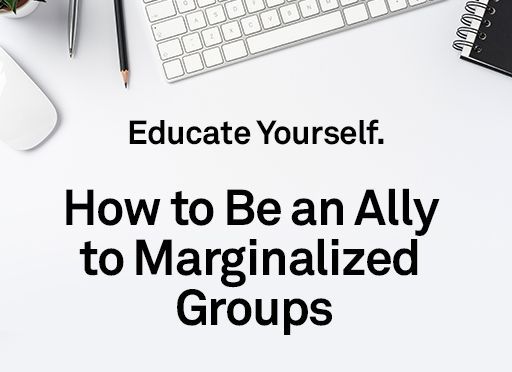“If a Diversity Expert Can Fail So Epically, Anyone Can.”

getAbstract: To get everyone up to speed, let’s start with a short introduction: What are subtle acts of exclusion?
Tiffany Jana: Subtle Acts of Exclusion is a new term for microaggressions. Michael Baran and I coined the phrase – SAE for short – to help destigmatize the idea of microaggressions and to make more progress on this important issue. We were inspired to write this book because of the lack of progress that we were collectively making on the topic of microaggressions and the way that they were causing serious harm to people, in terms of job satisfaction but also mental and physical health.
What’s the connection between SAE and unconscious bias?
Tiffany Jana: They are connected to bias because they tend to extend from the places where we have bias about people and their various identities. We are often unaware of our own biases, and by extension, we commit SAE unknowingly. Unfortunately, our ignorance of our unconscious bias does not mitigate the impact and harm caused by our exclusive words or actions.
How do you recommend dealing with these instances on an individual, institutional or societal level?
Michael Baran: The first step for everyone is to recognize that they are happening, and frequently, and so we should expect them to happen. Once we do that, we can prepare for how we’re going to react, whether we are the person who experienced the SAE, the person who initiated it, or the person who observed it. It all goes best when an organization gets on the same page about SAE – what they are, how to have productive conversations, and how to collectively feel like we’re addressing them together because it’s important to all of us. That being said, the guidelines can certainly help individuals, and the more people get on board, the better we’ll be at addressing these at a societal level.

Specifically, if you’re someone who experiences or witnesses an SAE: How should you respond?
Michael Baran: You first take stock of the situation. What am I feeling? Who is around? What is the setting? Is it appropriate to speak up now? Am I ready for this conversation? If you decide it is a good time to speak up, then you can make sure to pause the action, even if you don’t yet know what to say. Something like, “Can we pause to discuss something that was just said?” Then, if you think the person didn’t have bad intentions, you can be explicit about letting them know that, by saying something like, “I’m sure you didn’t mean anything bad by this, but…” Then call the person in, rather than calling them out. See if you can explore together the impact that the SAE had on you, or that you think it may have had on someone else, by using the framework in the book. You might try saying, “When someone asks me where I’m ‘really’ from like that, it makes me feel like I don’t belong here.”
What response is appropriate if you accidentally excluded someone else?
Michael Baran: If you are the person who said an SAE and you notice it as soon as it comes out of your mouth, you can also pause the action and discuss. This is powerful self-awareness. And if you are the one getting the feedback about an SAE you said or did, you have a huge responsibility to not get defensive, but to explore the intent of your words or actions.
Explicitly thank the other person for speaking up and use that opportunity to build a closer, more trusting relationship.
Michael Baran
Could you give us an example where you personally committed or addressed a subtle act of exclusion?
Tiffany Jana: The first time I brought one of my children to a diversity training gig, she was 12 years old. The client was a park. So, during one of the breaks I saw what appeared to be another child wearing a park shirt. I was ecstatic so I exclaimed “Oh look! It’s the tiniest little park employee!” A few minutes later I realized what I had done. Why would a child have on the facility uniform? I had just insulted an adult! I was primed by having my child at work all day and made a wrong assumption.
How did you react?
Tiffany Jana: I attempted to make it right and upon closer inspection, the person still looked all of 12, so I asked, “Are you a grown-up?” I doubled down on the insult even as I attempted to explain that I had my child with me and I was not paying close enough attention. I apologized profusely. She was gracious and said it happened all the time. Her colleagues, however, were giving me the stink eye. And the worst part is that I was there to lead diversity training for some of their colleagues!
This is why I insist that we all have grace for ourselves and grace for others when we are trying to expand our cultural fluency.
Tiffany Jana
Remember, if a diversity expert can fail so epically, anyone can. Don’t beat yourself up and try to be kind when others fumble around you.
Michael Baran: Once I was speaking on unconscious bias to a corporate audience. During the question-and-answer period, a white woman asked a question about what I would suggest doing with a boss – also white – who casually used the N-word, quoting a song lyric, during a meeting they had. I asked, “Has he done it more than once?” The moment it left my mouth, I realized I had made an unfair assumption about the speaker’s gender. In this case, I don’t think it was the fact that I heard the word, “boss” and assumed that person would be male. But rather, I think I heard the story and assumed that the person casually using the N-word like that would be male. But maybe it was both of those things. This was definitely an example where I felt the need to call attention to it immediately, which I did in front of the whole group. And of course, I used it as a teachable moment! It allowed me to illustrate how we are all susceptive to unconscious biases. And it allowed me to model what it looks like to speak up rather than trying to let an SAE like this fly under the radar unnoticed.

Since 2001, the getAbstract International Book Award has been presented annually to books that make a particularly important contribution to current economic, social and business-related topics. In this anniversary year, the prize will be awarded symbolically through a series of interviews and digital events. Find out more here.
In your book, you recommend addressing subtle acts of exclusion before they happen to create awareness and help people respond to them when they happen. If you don’t work in a company that has this awareness as part of its culture, is there a shortcut?
Tiffany Jana: We really do recommend embedding the SAE Accountability System into the workplace to normalize calling people in safely. In the absence of that, people must proceed with caution.
The nature of organizations is such that power dynamics are almost always in play.
Tiffany Jana
Absent an SAE Accountability System in which executive leadership expects employees to address SAEs in the moment or ASAP in service of greater inclusion – people have to choose their battles. I would say that if you have a solid rapport with the person you are calling in, proceed with grace. The time to ignore it is when you are in the extreme minority, have little relative power, and the SAE initiator has little or no relationship with you and the ability to affect your employment status.
Tiffany, you work in different cultural contexts. Do you find you have to adjust your message or approach depending on the company or country you’re in? Is the book globally applicable?
Tiffany Jana: The book is definitely globally applicable! We are getting comments, thanks, and fans from around the world! The key to navigating global contexts is to remain aware that while every nation might not suffer from the precise original sins against BIPOC that plague the American collective narrative, every nation has an origin story that often excluded or exploited someone. Nations also have contemporary histories that injure and exclude. Becoming aware of the specific exclusions and cultural contexts for each locale is an important part of grounding these lessons and tools in service of greater inclusion.
Your book was launched in March 2020, briefly before the death of George Floyd led to protests around the world and an intense interest in topics of racism, anti-racism and allyship. How has this timing affected your book’s reception?
Michael Baran: Certainly, after the murders of George Floyd, Breonna Taylor, Rayshard Brooks and others, people’s attention turned to the topics of racism, anti-racism and allyship in the United States – and globally – in new ways. While it’s unfortunately not a new phenomenon, many people’s eyes are opening in new ways. And one of the first steps is to learn deeply about the issues involved, so they are turning to books on the topics in record numbers. We are thankful that people are turning to our book as well. While our book does not directly address the explicit murders, it points to an important piece of the puzzle. If we hope to really create a world free from racism, where all people are truly valued for who they are, then we need to address all of it – the systemic injustices, the unconscious biases, and the subtle acts of exclusion that perpetuate unequal systems and patterns of thinking. Calling attention to these subtle acts of exclusion in the way that we have helps open people’s eyes to the subtle ways that people are still devalued, and that is critical to address if we really hope to make progress. Also, as more people think and talk about race and racism for the first time, they are committing SAE all the time!
The guidelines for having productive conversations – where true listening happens, where feedback can be given and received with grace – has never been more important.
Michael Baran
Some people argue that the awareness that diversity training raise doesn’t lead to behavioral change. How would you respond to such criticism?
Michael Baran: It’s certainly true that not all diversity, equity, and inclusion trainings lead to behavioral change. Many are focused just on awareness, and they stop there, without getting into practical, relevant solutions. That is not how Tiffany and I work. In this book, we build deep understanding and we provide practical, applicable guidelines. We’re proud of both of these goals. First, we have heard people explaining that the examples we use, the stories we tell, the vulnerability we show, and the depth of social science research and explanation are allowing people to understand the issues in entirely new ways. That’s critical. Second, we have seen entire organizations adopting the SAE Accountability framework because of its practicality, its focus on building connection between people, and its accountability.
What aspects of your approach do you feel make it more applicable?
Michael Baran: I’ve heard people at organizations saying things like, “We did unconscious bias training before, but really didn’t know what to do after that, to really put it into practice. I looked and looked for the next step, and when I read this book, I finally felt like I found it.” The book is able to do that by providing an opportunity and guidelines for people to actually address the unconscious biases that lead to SAE. It provides practical guidelines for bold, authentic conversations about these – and other – topics. The book is enabling skills for giving and receiving tough feedback, giving action steps for true allyship, and creating a culture of openness, transparency, and accountability to really make a difference for diversity, equity, and inclusion.
About the Authors
Tiffany Jana is the CEO of TMI Portfolio, a collection of companies working to advance inclusive workplaces. TMI Consulting, a TMI Portfolio company, is a 2018 Best for the World B Corporation. Jana is also the coauthor of Overcoming Bias and the second edition of the B Corp Handbook.
Michael Baran is a social scientist and senior partner and digital solutions lead at inQUEST Consulting. He has taught at Harvard University and worked as a principal researcher at the American Institutes for Research.







